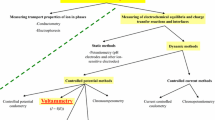Abstract
Audiofrequency methods were used to measure dielectric constants of dilute solutions containing electrolytes up to free-ion concentrations of 10−4 M. Using a calibrated transformer bridge, capacitance was measured with an accuracy of 0.03 pF at a conductance of 100 μmho and within 0.3 pF at 800 μmho. Evaluation of the double-layer capacitance from the frequency dependence of the data is discribed. The effect of the free ions on the dielectric constant is found to be relatively large and in reasonable agreement with the prediction of the Debye-Falkenhagen theory. The calculation of the electric dipole moment for polar solutes, including ion pairs, is discussed in terms of Kirkwood's theory. Experimental tests are described for finding out whether possible deviations of Kirk-wood's correlation factors from unity may be neglected. These tests involve changing the solvent and the temperature. The tests were satisfied for the ion pairs of tetraisoamylammonium nitrate and for nitrobenzene in chlorobenzene and acetic acid.
Similar content being viewed by others
References
For a recent review, seeIons and Ion Pairs in Organic Reactions, M. Szwarc, ed. (Wiley-Interscience, New York, 1972), Vol. 1.
T. E. Hogen Esch and J. Smid,J. Am. Chem. Soc. 87, 669 (1965);88, 307, 318 (1966).
See, for example, A. L. McClellon,Tables of Experimental Dipole Moments (W. H. Freeman and Co., San Francisco, 1963);
M. M. Davis,Acid-Base Behavior in Aprotic Organic Solvents, National Bureau of Standards, Monograph 105, Washington, D.C., 1968.
L. Onsager,J. Am. Chem. Soc. 58, 1486 (1936).
J. G. Kirkwood,J. Chem. Phys. 7, 911 (1939);
J. G. Kirkwood,Trans. Faraday Soc. A42, 7 (1946).
W. R. Gilkerson and K. K. Srivastava,J. Phys. Chem. 65, 272 (1961).
K. S. Pribadi and R. L. Kay,Rev. Sci. Instr. 40, 726 (1969).
R. L. Kay, G. A. Vidulich, and K. S. Pribadi,J. Phys. Chem. 73, 445 (1969); G. A. Vidulich, D. F. Evans, and R. L. Kay,ibid.,71, 656 (1967).
D. C. Grahame,Chem. Rev. 41, 441 (1947);
D. C. Grahame,J. Am. Chem. Soc. 68, 301 (1946);
D. C. Grahame,J. Am. Chem. Soc. 76, 4819 (1954).
P. Debye and H. Falkenhagen,Physik. Z. 29, 401 (1928);
H. Falkenhagen,Electrolytes (Clarendon Press, Oxford, 1934.
H. Falkenhagen and G. Kelbg, inModern Aspects of Electrochemistry, J. O'M. Bockris, ed. (Butterworths Scientific Publication, London, 1959), Vol. 2.
C. F. J. Böttcher,Theory of Electric Polarization (Elsevier Publishing Company, Amsterdam, 1952), p. 191.
Resistors, Technical Bulletin, General Radio Co., West Concord, Massachusetts.
Gertsch 1969 Catalog (Singer Instrumentation, Los Angeles), p. 66.
Balsbaugh Laboratories, 25 Industrial Park Rd., So. Hingham, Massachusetts 02043.
C. A. Kraus and R. M. Fuoss,J. Am. Chem. Soc. 55, 21 (1933).
M. R. Crampton and E. Grunwald,J. Am. Chem. Soc. 93, 2990 (1971).
L. M. Tucker and C. A. Kraus,J. Am. Chem. Soc. 69, 455 (1947).
A. W. Adamson,Physical Chemistry of Surfaces (Interscience Publishers, New York, 1967), pp. 210–216.
See, for example, J. D. Ferry,J. Chem. Phys. 16, 737 (1948).
See, for example, J. D. Jackson,Classical Electrodynamics (John Wiley and Sons, New York, 1962), pp. 177–178.
J. B. Hasted and G. W. Roderick,J. Chem. Phys. 29, 17 (1958), and references cited therein;
K. Giese, U. Kaatze, and R. Pottel,J. Phys. Chem. 74, 3718 (1970).
R. M. Fuoss,Proc. Nat. Acad. Sci. U.S. 45, 807 (1959).
R. H. Boyd,J. Chem. Phys. 35, 1281 (1961).
R. Zwanzig,J. Chem. Phys. 38, 1603 (1963).
W. R. Gilkerson and K. K. Srivastava,J. Phys. Chem. 64, 1485 (1960).
C. W. N. Cumper and P. G. Langley,Trans. Faraday Soc. 67, 35 (1971).
K. Bauge and J. W. Smith,J. Chem. Soc. 4244 (1964).
Author information
Authors and Affiliations
Rights and permissions
About this article
Cite this article
Grunwald, E., Effio, A. Electric dipole moments in polar solvents. I. Audiofrequency measurement with slightly conducting solutions. J Solution Chem 2, 373–392 (1973). https://doi.org/10.1007/BF00713251
Received:
Revised:
Issue Date:
DOI: https://doi.org/10.1007/BF00713251




